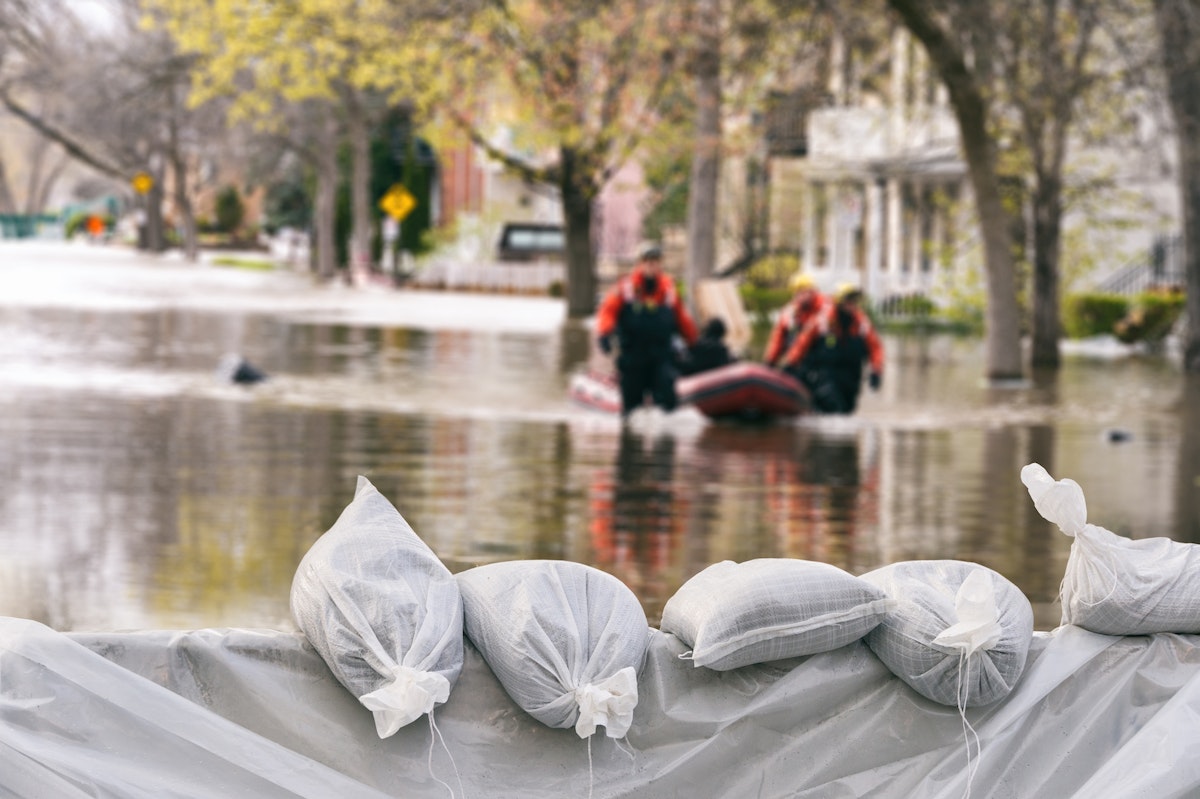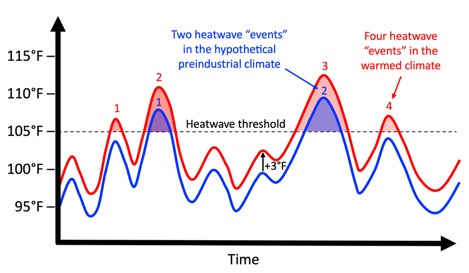Turning Down the Temperature on Extreme Claims About Extreme Weather
A genre of studies has emerged that purports to blame large portions of extreme weather impacts on climate change—but these studies make one big basic error.

-
-
Share
-
Share via Twitter -
Share via Facebook -
Share via Email
-
Editor’s note: The Liberal Patriot and The Breakthrough Institute are pleased to present the inaugural piece in our new collaborative series “The Climate Report” looking at the science and reporting behind extreme weather events and other climate related matters. To receive the series directly in your inbox, please subscribe here.
***
We've all seen the headlines:
“At Least 1,500 Britons Have Died Due to Climate Change-Related Heatwaves in Last 20 Years,” reads one from activist group Global Citizen. “Climate change toll from two droughts tops $800m,” reads another from the New Zealand outlet Stuff, “Climate crisis to blame for $67bn of Hurricane Harvey damage—study,” reads a third from The Guardian.
These headlines not only purport to quantify the contribution of climate change to extreme weather, they take the additional step of assigning impacts—dollars or lives lost—to climate change. They are also all founded on studies that themselves rest on a fundamental conceptual error that systematically inflates these costs.
This error, which I delve into in a recent peer-reviewed article, has to do with a miscategorization of weather and climate phenomena as discrete, countable events—yes-or-no, on-or-off occurrences—rather than recognizing the reality that extreme weather and climate changes are on a continuum of intensity.
The most straightforward way of thinking about how climate change affects the weather is to consider how it affects the intensity of that weather—not the overall number of extreme weather events. The remarkably extreme rainfall associated with Hurricane Harvey in the Houston area, for example, was probably made between eight to twenty percent more intense by climate change. Further modeling indicates that the increased rainfall amounted to an additional $13 billion in flood damage, or about 14 percent of the total $90 billion cost of the storm.
That’s a lot. But it’s five times smaller than the $67 billion—or three-quarters of the total cost—that The Guardian headline says can be blamed on climate change.
The smaller number based on changes in rainfall intensity is the correct way to think about the influence of climate change, and the larger number is incorrect because it is based on the erroneous notion that rainfall amounts can be thought of as discrete, countable “events.” Put another way, climate change doesn’t create storms like Hurricane Harvey—but it does make them more intense on the margins.
This error traces its origins to an article published in 2003 in Nature, the world’s most prestigious scientific journal, titled “Liability for climate change.” It has since gone viral and become prominent—for example, it is endorsed by the authoritative Intergovernmental Panel on Climate Change (IPCC) in their Sixth Assessment Report. Here’s the key passage in the original Nature article:
If…past greenhouse-gas emissions have increased the risk of a flood tenfold, and that flood occurs, then we can attribute…90 percent of any damage to those past emissions.
At first glance, this sounds logical—which is perhaps why it has survived for so long. But the devil is in the details, and this logic does not survive scrutiny when you delve into the details.
To get technical for a moment, this method uses something called the “fraction of attributable risk” that purports to quantify the proportion of an extreme weather or climate “event” attributable to climate change. When you see a headline that says a heatwave would have been impossible without climate change, for instance, it’s saying that the fraction of attributable risk was 100 percent.
This concept was borrowed from epidemiology, and the general idea is to quantify how a change in conditions affects the risk of a certain outcome. The fraction of attributable risk can quantify how exposure to a particular chemical affects the risk of contracting cancer, for example. If exposure to the chemical doubles the risk of cancer and an exposed individual contracts cancer, then half of the risk of contracting of cancer can be attributed to that exposure.
The genre of climate studies in question makes an analogous calculation on extreme weather “events.” But these studies take the further step of assigning impacts like economic damages or deaths to climate change by simply multiplying observed consequences by a calculated fraction of attributable risk. So, for Hurricane Harvey, these studies calculated that the fraction of attributable risk was 75 percent, and therefore about $67 billion out of $90 billion in storm damage could be blamed on climate change.
Ultimately, however, this calculation is wrong because the weather and climate phenomena in question—like rainfall amounts, flood depths, drought measures, and temperature values—are not properly conceived of as discrete binary “events” like contracting cancer. In order to shoehorn these phenomena into this framework, researchers use arbitrary thresholds (e.g., crossing some rainfall total, temperature, or drought index) to define countable events.
Let’s break down how this works with an example.
The figure below shows hypothetical changes of temperature over time, where the red line represents the current climate and the blue line represents the same temperature variability in a 3°F cooler preindustrial climate.
When certain meteorological factors come together, temperatures far above normal—say 20°F above normal—might occur. But we can see that climate change would only be responsible for the additional 3°F. Of course, a strong heatwave can also be responsible for plenty of negative effects—damage to GDP, deleterious health outcomes, reduced crop yields, and so on—but only those additional effects associated with the additional 3°F could plausibly be blamed on climate change.
But the genre of studies in question neglects this obvious fact and instead define countable “events” as the crossing of a particular temperature value. In this hypothetical example, the heatwave threshold is defined as 105°F (black dotted line). Using that definition of a heatwave, a researcher can claim that the number (or frequency or probability) of heatwaves has doubled in the warmed climate (four versus two). Then the researcher can go on to claim that the impacts from heatwaves have also doubled, and thus half of all impacts can be blamed on climate change!
This calculation would only be correct if there were zero impacts for temperatures below the heatwave threshold and constant impacts for temperatures above the heatwave threshold, as if flipping a switch. But that’s obviously false: impacts scale with temperature, not the number of times an arbitrary threshold is crossed. Quantifying these impacts as a function of intensity is much more difficult to do practically, but as we saw with the Hurricane Harvey example a proper calculation will almost certainly be substantially lower than those calculated with an erroneous method. What’s more, comparing the contemporary climate to the preindustrial climate is not particularly relevant because society today is better conceived of as being adapted to the contemporary climate than to the climate of the 1800s.
Despite these methodological problems, this genre of climate study is trumpeted far and wide. The erroneous study attributing 75 percent of Hurricane Harvey’s damage to climate change was in the 99th percentile of over 20 million research outputs tracked in terms of online attention. It was cited prominently (five times) in the latest IPCC Report and was promoted on social media by high-profile climate communicators, endorsed by a climate scientist on Time’s 100 most influential people list, and was the basis for sensationalist headlines like the one above in The Guardian.
This widespread misreporting of climate impacts matters because it undermines trust in climate science—and because it can be used to support policies that are ultimately unjustified.
The authors of the Harvey study also explicitly argue that their work has political implications by, for example, informing lawsuits. They contend their study demonstrates that traditional estimates of the social costs of carbon are severely underestimated, and their work should motivate stricter greenhouse gas emissions reductions in a cost-benefit framework that takes into account both the costs of emissions reductions and the benefits of reduced climate change. These inflated costs of climate change will thus justify overreactive policies like blanket bans on all new natural gas projects in low-income countries—policies that can do more harm than good.
Overall, then, these studies take the notion that climate change is responsible for the entirety of an event and make it mathematically explicit. But this same erroneous notion is implicit in all framing of extreme weather that discuss changes in frequency, likelihood, or probability: the entirety of any single extreme weather event is blamed on climate change even though the vast majority of its measurable intensity would have been there even without climate change. That leaves the public and policymakers with the impression that climate change is responsible for a much higher portion of extreme weather and its impacts than it actually is.
If we want the public to regain trust in science and for climate policy decisions to be made on the most accurate information, the relationship between climate change and extreme weather must be quantified and communicated with much more accuracy.

